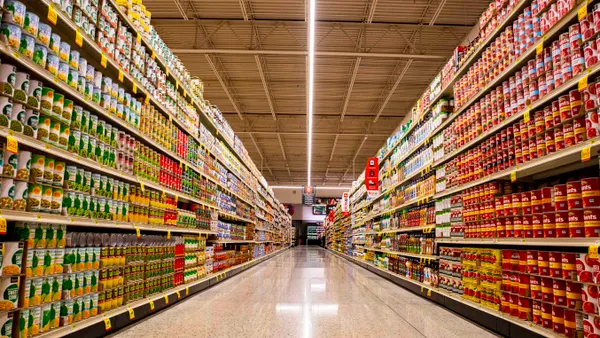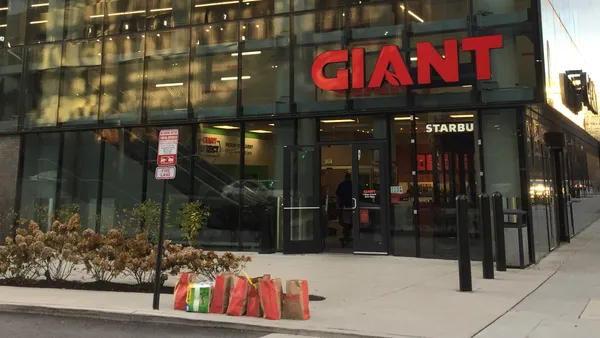If the sudden demise of Plenti, the highly publicized coalition loyalty program that discontinued operations this summer, was an indication of customer sentiment toward loyalty programs, there might be some questions about their value. But Plenti's downfall was not surprising to industry experts.
“Plenti had challenges to begin with, working as a coalition,” Mark Johnson, CEO of Loyalty360, a trade association for customer loyalty that works with brands, restaurants, hotels and grocers, told Food Dive. “It wasn’t a clearly understood program, and many retailers still ran concurrent programs.”
Johnson said that today, the goal for loyalty programs is to be relevant and timely to consumers and their preferences, and to create a dialogue between the customer and the brand.
So while grocery loyalty programs have been around for years, they may be more important than ever in today’s competitive landscape. The trick is crafting the right offering for today's consumer.
“I think there is a great need for simplicity in these programs,” Johnson said.
How loyalty benefits the grocer and the customer
The benefit of loyalty programs for grocers is clear – they provide access to customer data, shopping patterns and behavior and a direct line to the consumer, which ultimately helps the grocer drive sales among existing shoppers.
“The loyalty card allows retailers to understand who their shoppers are in a more significant way,” said Diana Sheehan, vice president of retail and shopper insights for Kantar Consulting. “It allows them to elevate how they communicate with their shoppers, it allows them to explore how to optimize their offers to meet shoppers' needs because they know their purchase behavior.”
Traditionally, Johnson said loyalty programs centered on purchase frequency and monetary spend, but now they are more focused on personalization and use of data through one-to-one relationships with customers. Additionally, highly regulated environments today make customer loyalty even more important.
“As states become more restrictive in policies around marketing, these programs will become even more important," Johnson said. "You’ll have that explicit permission to market to customers based on their participation in the program."
But what about the customer benefits? There is no limit to how many loyalty programs a person can join, no matter how frequently they shop somewhere. When shoppers can be treated as “loyal” almost anywhere, what programs actually work well and keep them coming back?
According to Colloquy’s 2017 Loyalty Census, there are 142.5 million individual loyalty memberships in the U.S. grocery industry, and customers are motivated to use programs that are easy to understand.
The key, according to Sheehan, is for a grocer to have a program that's unique and that offers benefits consumers actually value.
“Is it differentiating, or is it simply a piece of plastic that allows people to track purchases and basically give 80% of shoppers a good deal?” said Sheehan.
Best practices in customer loyalty
According to Johnson, Safeway, H-E-B, Kroger and Hannaford are among the strongest customer loyalty programs in the business.
Safeway, which is owned by Boise, Idaho-based Albertsons, has a two-part loyalty program that is integrated on Safeway’s Just4U app for customer-facing purposes, with customers enrolled in both programs through their phone number.
“Is it differentiating, or is it simply a piece of plastic that allows people to track purchases and basically give 80% of shoppers a good deal?”

Diana Sheehan
Vice President of Retail and Shopper Insights for Kantar Consulting
One component of the program is Safeway’s Just4U coupon program, which is based on an algorithm that matches coupons and deals for customers on a personalized basis.
“The coupon-based side is extremely effective, and customers love our program largely because we personalize it," Narayan Iyengar, senior vice president of digital marketing and e-commerce for Albertsons, told Food Dive. "That’s a big place where Safeway has been playing a cutting-edge role for years now.”
The second part of Safeway’s customer loyalty program is a points system that customers can redeem for gas rewards. Iyengar said that customers who use gas rewards really value them, however some customers report never using their gas rewards. This motivated Safeway to pilot a new option where customers can redeem points in the grocery store rather than at the gas pump. The company started rolling this option out last year, and will increase the number of stores where it is available this year.
“Altogether, this gives us a very compelling set of loyalty offerings that our customers have come to love,” Iyengar said. "The coupons tend to drive shoppers to come to the store on a specific day, while the rewards program with points encourages people to come in regularly.”
Kroger, meanwhile, sees 8 million regular shoppers and captures 97% of those transactions through its loyalty card and other measures, according to the company. While Kroger’s program focuses on fuel rewards, there is also a great deal of effort to create personalized, targeted offers for program members. Johnson said this is an attempt to drive behavior and incremental purchases.
“They [Kroger] know you very well, and at the end of the day they want you to check in,” Johnson said. “That’s why they prompt you to put in your phone number before, during or after the transaction. They realize the importance of that disparate and very rich data set that you give them.”
Hannaford, which operates stores in New York and New England, recently began a new program that analysts consider exemplary. The My Hannaford Rewards program launched in all stores in January. It offers customers a 2% reward on every store-brand item purchased, and the dollar-based reward is redeemed quarterly and comes off the customer’s bill at the register, said Hannaford Spokesman Eric Blom.
“If you look at innovation, honestly the most innovative concept I’ve seen in grocery is Hannaford,” said Sheehan. “They’ve moved to a cash-back model, which isn’t necessarily new, but it’s new to grocery, and it appeals to shoppers.”
Customers can sign up for the program online or through the Hannaford app, where they can also select the coupons that interest them. There are no cards, no points and no paper coupons.
“We wanted something that was simple for customers and valuable to them," Blom said. "When we do that, we are able to earn customers’ business."
Does loyalty have to be driven by programs?
Despite the prevalence of loyalty programs, some of the biggest names in grocery today, including Walmart and Aldi, operate without official loyalty programs.
“Loyalty does not have to be connected to loyalty programs,” said Sheehan. She said that while some retailers have customized programs, others have reliable customer service that brings shoppers back.
“If you look at it from a holistic level, loyalty among core shoppers is really the essence of what a stable business is,” Sheehan said.
But for Iyengar, there is good reason for Safeway and other Albertsons stores to stick with the loyalty program model.
“It is often way more cost-effective for companies to encourage customers to expand their share of wallet than it is to go and find a new customer," Iyengar said. "That’s the basis of the entire loyalty program."
In the future, he expects there will be continued growth in the number of people who sign up for loyalty programs as well as the number of retailers who offer them.
Trends and the future of customer loyalty programs
With the grocers facing considerable disruption across their operations, it comes as no surprise that tech companies are taking aim at loyalty programs. Platforms such as Fetch and AppCard are challenging the idea of traditional marketing and loyalty with smarter use of digital tools, data and analytics.
AppCard, which was founded in 2011, uses data and artificial intelligence to create personalized loyalty offers and increase customer retention. AppCard works with grocers including Lowes Foods, Sendiks, Foodtown and Super King.
“For decades, brick-and-mortar retailers, like grocery stores, have had a very nice relationship with their shoppers, perhaps even knowing them by name,” Merrick Rosner, vice president of enterprise accounts for AppCard, told Food Dive in an email. “But times are changing, and shoppers’ expectations are changing along with it.”
Rosner said personalization and automation are key. Shoppers want the right message at the right time and at their preferred touch point. In the future, AppCard anticipates sending more personalized text messages and push notifications.
Albertsons is well aware of these trends and is working to increase automation and personalization in its stores, including Safeway. Iyengar said that as new technologies develop, stores will be able to offer more in-store opportunities such as real-time coupons and rewards and more personalization options – most likely through push notifications on their store app.
“For decades, brick-and-mortar retailers, like grocery stores, have had a very nice relationship with their shoppers, perhaps even knowing them by name. But times are changing, and shoppers’ expectations are changing along with it.”

Merrick Rosner
Vice President of Enterprise Accounts for AppCard
“This is a very, very rich space. It is truly exciting how all of this is evolving,” Iyengar said.
For grocery companies that don't want to invest in their own loyalty program, third-party applications like AppCard offer an alternative solution.
“Our grocery store owners entrust us to engage their shoppers in a responsible and innovative way to retain and grow their shopper base,” Rosner, with AppCard, said. “This allows the grocer to continue to do what they do best in store while we bridge the digital gap for them.”
Whether a grocer has a loyalty program or not, and no matter how it is designed, a grocer’s brand identity may be the most important factor in whether or not customers remain loyal.
“The key is to stay consistent. Don’t try to constantly vacillate around what you are as an outward-facing brand and what your brand message or mission statement may be,” Johnson with Loyalty360 said.











